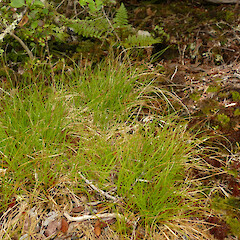Carex erebus
Common name
Hooker’s bastard grass
Synonyms
Uncinia hookeri Boott; Uncinia riparia R.Br. var. hookeri (Boot) Kük.
Family
Cyperaceae
Flora category
Vascular – Native
Endemic taxon
No
Endemic genus
No
Endemic family
No
Structural class
Sedges
NVS code
The National Vegetation Survey (NVS) Databank is a physical archive and electronic databank containing records of over 94,000 vegetation survey plots - including data from over 19,000 permanent plots. NVS maintains a standard set of species code abbreviations that correspond to standard scientific plant names from the Ngä Tipu o Aotearoa - New Zealand Plants database.
UNCHOO
Chromosome number
2n = 88
Current conservation status
The conservation status of all known New Zealand vascular plant taxa at the rank of species and below were reassessed in 2017 using the New Zealand Threat Classification System (NZTCS) – more information about this can be found on the NZTCS website. This report includes a statistical summary and brief notes on changes since 2012 and replaces all previous NZTCS lists for vascular plants.
Please note, threat classifications are often suggested by authors when publications fall between NZTCS assessment periods – an interim threat classification status has not been assessed by the NZTCS panel.
- Conservation status of New Zealand indigenous vascular plants, 2017 . 2018. Peter J. de Lange, Jeremy R. Rolfe, John W. Barkla, Shannel P. Courtney, Paul D. Champion, Leon R. Perrie, Sarah M. Beadel, Kerry A. Ford, Ilse Breitwieser, Ines Schönberger, Rowan Hindmarsh-Walls, Peter B. Heenan and Kate Ladley. Department of Conservation. Source: NZTCS and licensed by DOC for reuse under the Creative Commons Attribution 4.0 International licence.
2017 | At Risk – Naturally Uncommon | Qualifiers: RR, SO
Previous conservation statuses
2012 | At Risk – Naturally Uncommon | Qualifiers: RR, SO
2009 | At Risk – Naturally Uncommon
2004 | Not Threatened
Distribution
Indigenous. New Zealand: Antipodes Islands, Auckland Islands and Campbell Island/Motu Ihupuku. Also present on Macquarie Island.
Habitat
Mostly found in tussock grassland, usually at elevations of 300–600 m a.s.l. Also growing amongst seal colonies at sea level. rarely extending into forest on the Auckland Islands.
Detailed description
Dense, stiff tufts arising from a slender stoloniferous rhizome c. 1mm diameter. Culms 40–250 × c. 0.5 mm, glabrous; basal bracts dark brown. Leaves 5–9 per culm, much » flowering culms but usually only slightly < fruiting culms, 1.5–2.0 mm wide, dark green, rigid, involute, scabrid on margins and upper surface towards tip. Spikes 10–35 × c. 3 mm, greenish brown, female flowers c. 10–20, crowded towards top of spike with internodes 1–3 mm long, more distant in lower third of spike with internodes up to 4 mm long. Glumes ± = or slightly > utricles, deciduous, lanceolate, acute, membranous, light or dark brown, usually with a prominent green midrib and two very dark brown lateral veins, margin pale brown. Utricles 4–5 mm long, slightly < 1 mm diameter, trigonous or subtrigonous, oblong or lanceolate, light green, nerved, occasionally only faintly so on the two abaxial surfaces, slightly contracted at the base to a stipe c. 1 mm long, beak 1.0-1.5 mm long; strongly spreading when ripe.
Similar taxa
Carex erebus is closely allied to C. aucklandica (Hamlin) K.A.Ford from which it chiefly differs by its more markedly stoloniferous, densely tussock-forming growth habit, wider leaves and spikes, and by the darker coloured, mature utricles.
Flowering
November–December
Fruiting
December–February
Propagation technique
Can be grown from fresh seed and by the division of established plants, though these may then take a while to settle. Prefers a shaded site, and should be planted within a deep, rich, free draining but permanently moist soil.
Etymology
carex: Latin name for a species of sedge, now applied to the whole group.
Where To Buy
Not Commercially Available
Attribution
Description adapted from Moore and Edgar (1970). Fact sheet prepared by Peter J. de Lange 17 August 2006.
References and further reading
Moore LB, Edgar E. 1970. Flora of New Zealand, Volume II. Indigenous Tracheophyta: Monocotyledones except Gramineae. Government Printer, Wellington, NZ. 354 p.
NZPCN Fact Sheet citation
Please cite as: de Lange, P.J. (Year at time of access): Carex erebus Fact Sheet (content continuously updated). New Zealand Plant Conservation Network. https://www.nzpcn.org.nz/flora/species/carex-erebus/ (Date website was queried)











